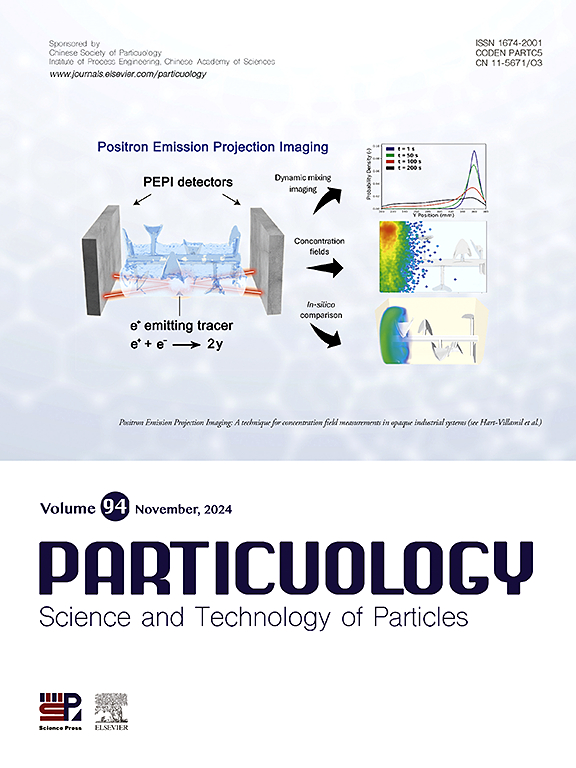Impact of the polydispersion of TiO2 materials on their particle size calculated from specific surface area results obtained during an interlaboratory comparison exercise
IF 4.1
2区 材料科学
Q2 ENGINEERING, CHEMICAL
引用次数: 0
Abstract
In this work, four samples of TiO2 powder materials with different structures (rutile, anatase), surface coatings and morphologies (rod, pseudo-spherical) were characterized by four partners involving complementary methods. With the aim of producing inter-laboratory reproducibility data, the specific surface-area, bulk density, and number size distribution were measured, yielding a satisfying agreement between partners. The equivalent diameter of constituent particles was determined from the sample volume specific surface area (VSSA) – accounting for polydispersion – and compared to electron microscopy (EM). Constituent particle diameters ranged from 15 to 225 nm according to EM analyses. The relative discrepancies between VSSA-based and EM-based diameters were found within ±20%. Out of the four samples under study, TiO2 μ-rutile leads to a larger deviation, which was attributed to surface coating thanks to complementary analysis. Assuming that the sample is pure, an equivalent diameter based on the VSSA can be determined, provided that the shape of constituent particles is known or supposed.

二氧化钛材料的多分散性对其粒径的影响是通过实验室间比较得到的比表面积结果来计算的
在这项工作中,4种不同结构(金红石型、锐钛矿型)、表面涂层和形貌(棒状、伪球形)的TiO2粉末材料样品通过4种互补方法进行了表征。为了产生实验室间的可重复性数据,测量了比表面积、体积密度和数量大小分布,在合作伙伴之间产生了令人满意的一致意见。组成颗粒的等效直径由样品体积比表面积(VSSA)确定-考虑多分散-并与电子显微镜(EM)进行比较。根据EM分析,组成颗粒直径范围为15至225 nm。基于vsa和em的直径之间的相对差异在±20%以内。在所研究的4个样品中,TiO2 μ-金红石的偏差较大,经互补分析,这是由于表面涂层造成的。假设样品是纯的,只要已知或假设组成颗粒的形状,就可以确定基于vsa的等效直径。
本文章由计算机程序翻译,如有差异,请以英文原文为准。
求助全文
约1分钟内获得全文
求助全文
来源期刊

Particuology
工程技术-材料科学:综合
CiteScore
6.70
自引率
2.90%
发文量
1730
审稿时长
32 days
期刊介绍:
The word ‘particuology’ was coined to parallel the discipline for the science and technology of particles.
Particuology is an interdisciplinary journal that publishes frontier research articles and critical reviews on the discovery, formulation and engineering of particulate materials, processes and systems. It especially welcomes contributions utilising advanced theoretical, modelling and measurement methods to enable the discovery and creation of new particulate materials, and the manufacturing of functional particulate-based products, such as sensors.
Papers are handled by Thematic Editors who oversee contributions from specific subject fields. These fields are classified into: Particle Synthesis and Modification; Particle Characterization and Measurement; Granular Systems and Bulk Solids Technology; Fluidization and Particle-Fluid Systems; Aerosols; and Applications of Particle Technology.
Key topics concerning the creation and processing of particulates include:
-Modelling and simulation of particle formation, collective behaviour of particles and systems for particle production over a broad spectrum of length scales
-Mining of experimental data for particle synthesis and surface properties to facilitate the creation of new materials and processes
-Particle design and preparation including controlled response and sensing functionalities in formation, delivery systems and biological systems, etc.
-Experimental and computational methods for visualization and analysis of particulate system.
These topics are broadly relevant to the production of materials, pharmaceuticals and food, and to the conversion of energy resources to fuels and protection of the environment.
 求助内容:
求助内容: 应助结果提醒方式:
应助结果提醒方式:


